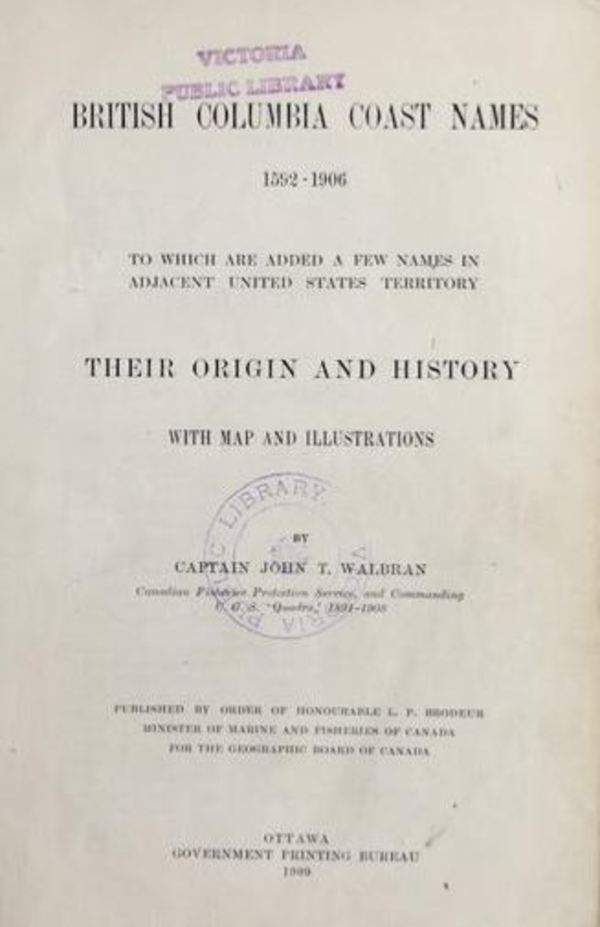
Source: Link
WALBRAN, JOHN THOMAS, master mariner and toponymist; b. 23 March 1848 in Ripon, England, son of Christopher James Walbran, an iron merchant, and Sarah Horsfall; m. 9 May 1871 Anne Mary Walbran in Baldersby, England, and they had two daughters; d. 31 March 1913 in Victoria.
John T. Walbran was educated at Ripon Grammar School, until at the age of 14 he became a cadet on the school frigate Conway, where he was trained for service in the British mercantile marine. He graduated in 1864. After a three years’ apprenticeship under sail, he received his second mate’s certificate in 1867 and his master’s papers on 2 June 1881. In 1888 he became chief officer on the steamship Islander being outfitted in Scotland. Aboard it, he arrived in Victoria on 9 December. Remaining in the service of the Canadian Pacific Navigation Company, he assumed command of the Danube in 1890. The next year he joined the federal government’s Marine service and brought out from Scotland its steamship Quadra, which he commanded until 1903, performing a number of services, chiefly concerning lighthouses, buoys, and fisheries on the west coast, but also including hydrographic research, the transport of police to deal with native troubles, and passage for Governor General Lord Minto [Elliot] on a cruise to Alaska. Walbran retired from the sea in 1904 and settled in Victoria, devoting himself to his hobby, tracing the origins of British Columbia’s maritime toponymy. This labour of love, for which he had been gathering data since 1896, culminated in 1909 in the publication of his massive British Columbia coast names, 1592–1906, the work upon which his fame rests.
In his labours, Walbran had a variety of sources, not only manuscript and printed texts reaching back to the 18th century (the private library of his friend Mr Justice Archer Evans Stringer Martin* of the British Columbia Supreme Court was a major help here), but letters from a legion of friends, many of them Royal Navy officers, veterans of service on the coast, to whom he addressed enquiries in England. Important also were Walbran’s interviews with missionaries, traders, and ships’ officers whom he was able to meet when commanding the Quadra.
British Columbia coast names bears little resemblance to modern directories of toponyms with their concise, even desiccated, entries. Rather it belongs in the tradition of 18th-century antiquarian writing, with its rich mass of anecdotes and digressions. Fascinated by the saga of James (Jemmy) Jones who, outwitting both British and American authorities, escaped to Mexico with the schooner that they sought to take from him, Walbran devotes to little Jemmy Jones Island in Baynes Channel almost double the space he gives to the city of Victoria. But he did not skimp in his research on the capital, even writing to Thomas Lowe in Scotland, probably the last survivor of the little group who had founded Fort Victoria in 1843. Digressions abound, especially where Walbran’s beloved Royal Navy is concerned; though Admiral Augustus Keppel was never in British Columbia, Walbran devotes approximately 700 words to his career. Walbran’s style can at times attain a sonority worthy of Gibbon, and always it is lucid, energetic, and trenchant. The good captain’s book is the foundation work on the origins of British Columbia’s coastal place-names. More than that, it is an amazing grab-bag of history, biography, and anecdote. On both scores it belongs in any library of British Columbiana.
Walbran died in 1913 partly in consequence of an automobile accident. In British Columbia he is commemorated in a number of place names, including Walbran Island and Walbran Point.
Walbran’s British Columbia coast names, 1592–1906 was first published in Ottawa and was reprinted, with an introduction by G. P. V. Akrigg, in Vancouver in 1971.
After his death, Walbran’s daughters destroyed his papers; however, some of his letters survive in government records, such as the “Old board files” held by the Canadian Permanent Committee on Geographic Names, Ottawa.
Church of Jesus Christ of Latter-day Saints, Geneal. Soc. (Salt Lake City, Utah), International geneal. index. General Register Office (London), Ripon, RBMB, 23 March 1848. Daily Colonist (Victoria), 1 April 1913. T. E. Appleton, “Captain John T. Walbran, 1848–1913,” BC Studies, no.5 (summer 1970): 25–35.
Cite This Article
G. P. V. Akrigg, “WALBRAN, JOHN THOMAS,” in Dictionary of Canadian Biography, vol. 14, University of Toronto/Université Laval, 2003–, accessed December 29, 2025, https://www.biographi.ca/en/bio/walbran_john_thomas_14E.html.
The citation above shows the format for footnotes and endnotes according to the Chicago manual of style (16th edition). Information to be used in other citation formats:
| Permalink: | https://www.biographi.ca/en/bio/walbran_john_thomas_14E.html |
| Author of Article: | G. P. V. Akrigg |
| Title of Article: | WALBRAN, JOHN THOMAS |
| Publication Name: | Dictionary of Canadian Biography, vol. 14 |
| Publisher: | University of Toronto/Université Laval |
| Year of publication: | 1998 |
| Year of revision: | 1998 |
| Access Date: | December 29, 2025 |



